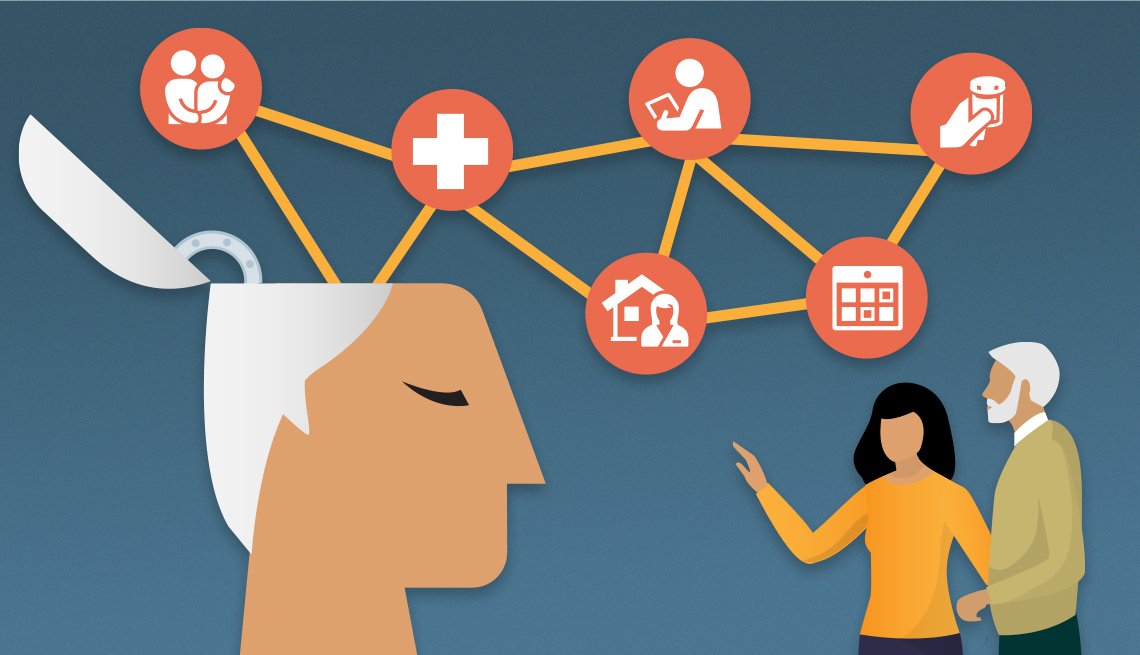Staying Fit
Gina Jaiman cared for her mother, Ana Martinez, in her Seattle home as her mother’s dementia progressed over two years. “I didn’t want her to go to a nursing home,” says Jaiman, 53, who works in administration as a facilities coordinator. “I understand culturally — and friends who are also Puerto Rican also understand — that lots of times it’s expected for you to take care of your parents.”
That decision became more difficult to endure as her mother needed more care. “I was taking care of her and working, and it was getting very stressful,” she says.


AARP Membership— $12 for your first year when you sign up for Automatic Renewal
Get instant access to members-only products and hundreds of discounts, a free second membership, and a subscription to AARP the Magazine.
Jaiman is not alone. Latino families are less likely to use formal care services, such as nursing homes, when a loved one is diagnosed with dementia, according to “Latinos & Alzheimer’s Disease: New Numbers Behind the Crisis,” a report from LatinosAgainstAlzheimer's, the USC Suzanne Dworak-Peck School of Social Work and UsAgainstAlzheimer's. Though relying on family support may cut down on initial expenses, it is not without costs in the long run.
The study, published in Innovation in Aging, estimates that by 2060, the number of Latinos living with Alzheimer’s disease will grow exponentially from 379,000 in 2012 to 3.5 million by 2060 — a growth of 823 percent. What’s more, indirect costs for Latinos with Alzheimer’s disease, including unpaid informal care and earnings lost, are projected to increase tenfold from $3.9 billion in 2012 to $39.8 billion (in 2012 dollars) in 2060, the "Latinos & Alzheimer's Disease” study says.
According to the Alzheimer’s Association, people 65 and older survive an average of four to eight years after a diagnosis, yet some live as long as 20 years with the disease. Taking care of someone as the disease progresses over an extended period can wreck even the most careful financial planning, and puzzling together how to do so can be daunting.


Latinos and Alzheimer's: A Growing Crisis
The latest research, getting a diagnosis, handling finances and coping with caregiving.
Medicare doesn’t cover the cost of custodial care — the help with bathing, eating, dressing and using the bathroom — that Alzheimer’s patients eventually need. Medicaid pays for care only if income and assets are below certain levels, and in some states, it can be complicated to get coverage for care outside a nursing home.
This makes it even more challenging for people who, like Jaiman, want to care for relatives with Alzheimer’s in their own home for as long as possible, as is often the case for the millions of Latinos who are caregivers. Of the estimated 48 million caregivers in the United States, about 21 percent are Latinos, according to AARP.
Even those providing the care themselves may struggle financially if they need to cut back (or leave) their jobs as their loved one starts to need round-the-clock help. About 40 percent of Latino caregivers take a leave of absence from work, cut back on hours or stop working entirely to care for their loved one, the National Institute on Aging reports. An AARP study last year found that the average annual out-of-pocket costs for Latino caregivers was $7,167, and they spent about 47 percent of their income on caregiving activities.
Though the cost of caregiving is often high, you may be eligible for programs and support that can help.
When Jaiman’s mother ended up in the hospital in 2012 for a broken hip, a social worker let Jaiman know about resources in Seattle that could help her care for her mother — including a Washington state program that paid family members to be their parents’ caregivers. She also learned about state and local programs that provided meal delivery, medical equipment, a nurse that came to their house once a month to check on her mother’s medications and respite care to give Jaiman an occasional break from caregiving.
Since Alzheimer’s is a progressive disease, meaning the condition worsens over time, there can be some time to prepare financially for the next stages. Here are some steps to consider taking as the disease advances and some resources to help you along the way.
Protect Your Loved One from Fraud
According to a study published in JAMA Internal Medicine, poor financial decisions may be an early warning sign of Alzheimer’s and related dementias. Among the findings: Those with dementia were more likely to have missed bill payments up to six years before being diagnosed and more likely to have subprime credit ratings up to two and a half years before diagnosis. As the disease progresses, it becomes increasingly difficult for those with Alzheimer’s to manage their own finances, which makes them susceptible prey for scammers. Visit the AARP Fraud Resource Center to learn how to protect your loved one from more than 70 common types of scams.
Stage 1: Early-stage Alzheimer’s
In the early stage of Alzheimer’s, the patient’s symptoms may vary widely. Memory lapses are common; so are misplacing objects and having trouble remembering names when introduced to people. Because those in the early stage of the disease can generally do most things independently — such as driving to work or taking part in social activities — it’s sometimes only those closest to them who may notice something is amiss.
The more financial planning that can be done soon after an Alzheimer’s diagnosis, the better prepared one will be for financial issues and expenses — especially while people can still make financial and caregiving decisions for themselves.
“The diagnosis is devastating, it’s difficult to accept, but somebody has to be able to take the wheel and plan ahead while the person is still able to make decisions,” says Robert Herrera, a financial counselor with the City of San Antonio Financial Empowerment Center, who helped care for both his in-laws when they had dementia.
Here are five steps to take:
1. Have a family meeting. “If their loved one has been diagnosed with Alzheimer’s, get together and create a plan together,” says Jen Hemphill, an accredited financial counselor and host of the Her Dinero Matters podcast who started her career as a gerontologist. “What is going to happen? This means talking about money, and that is difficult.”
Family members may be able to help in different ways. One might have more time to drive the parent to appointments and help them as they need more care. Another sibling may be able to help with financial paperwork and navigate the systems to make sure the parent is receiving all the benefits they are eligible for. Relatives who live far away may be able to visit for a while and give the primary caregiver a break.







































































